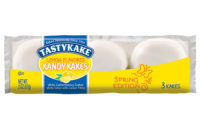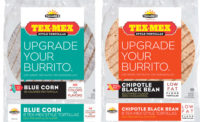State of the Industry 2016: Desserts get real, healthier and small
Cakes, pies and cheesecake—longtime dessert favorites—continue to adapt to changing consumer trends and demands.

courtesy of Campbell Soup Co

courtesy of The Eli’s Cheesecake Co.

courtesy of Campbell Soup Co.

courtesy of Tyson Foods

courtesy of FoodTools Consolidated Inc.

courtesy of Rich Products Corp.

courtesy of The Eli’s Cheesecake Co.

Dessert Sales

Dessert Sales

Dessert Sales

Dessert Sales

Dessert Sales

Dessert Sales

Dessert Sales














Despite Americans’ growing interest in healthier diets and better-for-you foods made with real ingredients, people still enjoy treating themselves to dessert, be it a piece of frosted layer cake, a slice of silky crème pie or a sliver of decadent cheesecake.
Overview | Bread | Tortillas | Sweet Goods | Snack Cakes | Pizza | Desserts | Cookies | Buns & Rolls | Bars | Breakfast Products
Even though Americans aren’t likely to give up dessert any time soon, they are re-examining these baked goods and opting for ready-to-eat products made with real ingredients and no artificial flavors and colors. Single-serve or scaled-down sizes are getting the nod, too, from health- and weigh-conscious consumers.
Market data
Sales in the desserts segment—cakes, pies and cheesecakes—were mixed during the 52 weeks ending April 17, 2016, per IRI, Chicago. Cakes saw dollar sales increase 7.05 percent during the period, to $1.4 billion. Refrigerated cakes, on the other hand, registered only a 0.95 percent sales increase, to $123.5 million. Sales of pies jumped 14.62 percent, to $405.4 million, and refrigerated pie sales increased 6.16 percent, to $28.2 million. Frozen pies, however, only saw a marginal sales increase of 0.08 percent, reaching $530.4 million. Refrigerated cheesecakes recorded sales of $238.1 million, up 5.7 percent. Frozen cheesecakes saw a more modest sales increase, 1.97 percent, to $137 million.
Private label brands topped six of seven dessert categories in terms of sales—cakes and refrigerated cakes, pies and refrigerated pies, and refrigerated and frozen cheesecakes. The Schwan Food Co. saw the highest dollar sales in the frozen pies category ($245.7 million), a sales increase of 1.40 percent for the 52 weeks ending April 17, 2016. Several companies registering less than $2 million in frozen pie sales saw their sales jump the most for these goods: Village Foods Inc., 39.01 percent; Cyrus O’Leary Pies, 31.04 percent; The Village Piemaker Inc., 24.60 percent; and Wick’s Pies Inc., 10.31 percent. Private label frozen pies, on the other hand, recorded the largest drop in sales—41.03 percent.
Looking back
Many familiar trends continue to dominate the desserts category. “We’re seeing that consumers are still interested in indulgence, which obviously ties closely with desserts,” says Pamela Oscarson, consumer insights manager, FONA International, Geneva, IL. “Consumers also want to know that the ingredients in their desserts are top-notch, which means ‘premium’ claims are rising.”
Desserts is still a category where decadence resonates with shoppers. “Decadent desserts are a prevailing trend,” says Debbie Marchok, vice president of marketing, The Eli’s Cheesecake Co., Chicago.
For consumers seeking a gluten-free treat, Eli’s recently introduced a Chocolate Hazelnut Crunch made with gluten-free ingredients. “It is our version of everyone’s favorite creamy chocolate hazelnut spread, folded into rich chocolate cheesecake with another layer of chocolate and hazelnuts, topped with a crunchy, chocolate confection,” explains Marchok. She notes that requests for gluten-free desserts remain popular.
Consumers are also concerned about the ingredients these products contain. “Real, back-to-basic comfort foods with recognizable ingredients is a big trend now,” says Joan Axelrod Siegelwax, executive vice president, Love and Quiches Gourmet, Freeport, NY. “People want eggs, people want flour, people want real, quality chocolate—and they want to know where it came from.”
Marchok notes that “consumer focus on the integrity of ingredients and desserts made with better-quality ingredients continues to gain momentum. From clean ingredient statements to gluten-free to GMO-free to dairy-free, the focus on ingredients continues to create demand for transparency by the consumer.”
Paul Bright, innovation manager, AB Mauri North America, St. Louis, says today’s consumers are looking for indulgent desserts free from allergens and artificial colors and flavors, as well as for indulgent products that are low in added sugars and low on the glycemic index. He notes customers are requesting more clean-label ingredients. He notes customers are also looking for solutions that eliminate partially hydrogenated oils, as well as non-GMO and certified-organic.
Bakers of desserts looking to go better-for-you have several options available to them, including rice bran ingredients, which “serve as great nutritional bulking agents for healthier desserts,” says Mark McKnight, senior vice president of sales and marketing, RiceBran Technologies, Scottsdale, AZ. The ingredients are all-natural, gluten-free, non-GMO-verified and rich in nutrients like dietary fiber and protein.
Better-for-you also means portion control. “Customers want to still experience their favorite sweet treats and will continue to do so,” says Bright. “They are now looking to enjoy mini variations of their favorite product.”
As Marchok notes, consumers believe in “everything in moderation”—but it has to taste great. “Mini desserts are still a big trend,” she says. Eli’s Cheesecake is introducing a line of individual tarts in four flavors—Butter, Lemon, Salted Caramel and Original Plain Cheesecake, each with a crisp pâte sucrée crust.
“Individually-sized desserts have become increasingly popular with consumers, leading to even more variety in the category,” says Matt Peno, brand manager, Sara Lee Desserts, Chicago, part of Tyson Foods. “Individual sizes provide portion control and versatility―families do not have to agree on one dessert to share because each person can now have their own single-serve treat.” They also offer busy consumers convenience.Sara Lee now offers individually packaged Cheesecake Slices in classic and strawberry, as well as Original and Double Chocolate Pound Cake Slices.
FoodTools Consolidated Inc., Santa Barbara, CA, offers a variety of cake slicers for bakers considering single-serve products. The ACC-2100URF ultrasonic ultrasonic roll feed divider—the company’s latest offline solution—is equipped with a full wave blade for tall products and can cut with or without divider inserts. The model is also available in an inline configuration for large bakeries. Options exist to cut multiple shapes.
Flavor innovation via twists on classic dessert favorites can also drive sales. Oscarson suggests adding tarragon to rhubarb strudel or basil and mint to a coconut cheesecake. “When you can innovate and try new flavor combinations, it’s exciting,” she says.
Krista Corigliano, senior marketing manager, desserts, and Mariah Kerwin, marketing manager, cheesecakes, Rich Products Corp., Buffalo, NY, say consumers are looking for familiar flavors with a twist.Red Velvet and carrot continue to be popular cake flavors, they say, and they are now translating over to cheesecake. The company also recently launched a line of pumpkin baked goods, which includes cheesecake and cake.
Looking ahead
Flavor and format versatility will help keep the dessert category fresh and on-trend in the coming year. Fusion and hybrid desserts—which combine cake, cheesecake and other baked goods—are making their way from small, independent bakeries to in-store bakeries in grocery stores, notes Corigliano and Kerwin. To support this development, the company launched Specialty Sweet Fusions, a hybrid dessert featuring moist traditional dessert cake, baked New York cheesecake and sweet cream cheese whipped icing. Two varieties are currently available: Carrot Cake Fusion and Red Velvet Fusion.
People’s penchant for snacking will also continue to impact the dessert category. “‘Dessert all day’ is another important trend,” says Siegelwax. “People are definitely snacking more. People are having dessert for breakfast. Because people are eating less traditionally and snacking all day long, it’s hoorah for dessert! We get to be part of that.”
Overview | Bread | Tortillas | Sweet Goods | Snack Cakes | Pizza | Desserts | Cookies | Buns & Rolls | Bars | Breakfast Products
Looking for a reprint of this article?
From high-res PDFs to custom plaques, order your copy today!




















